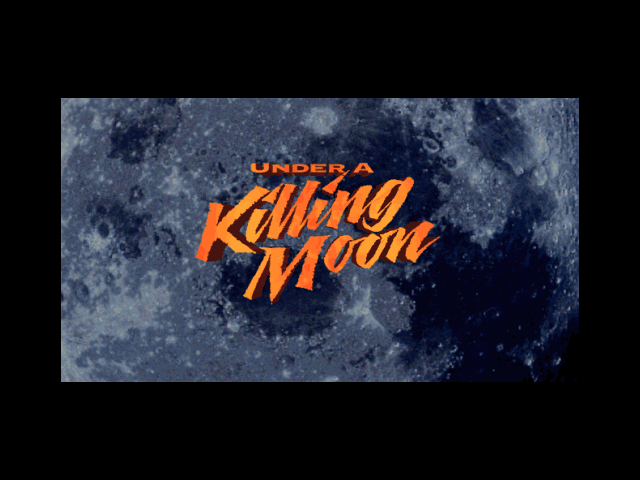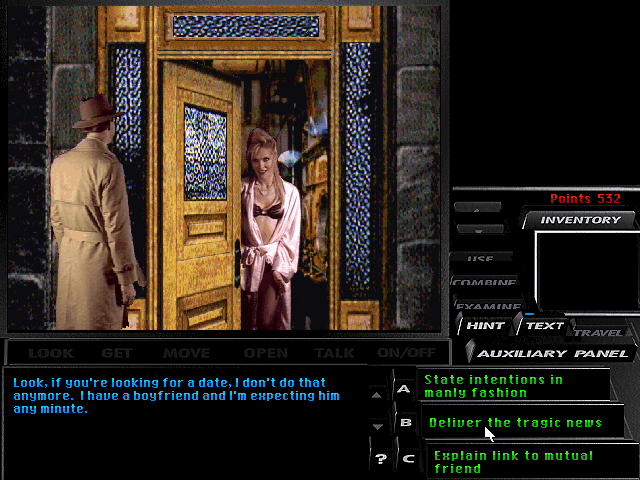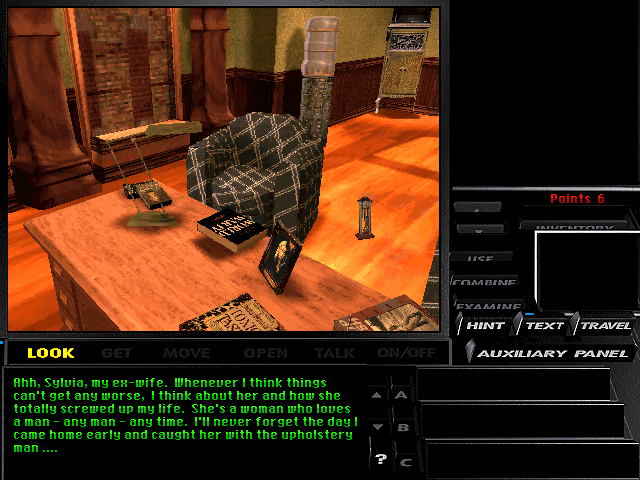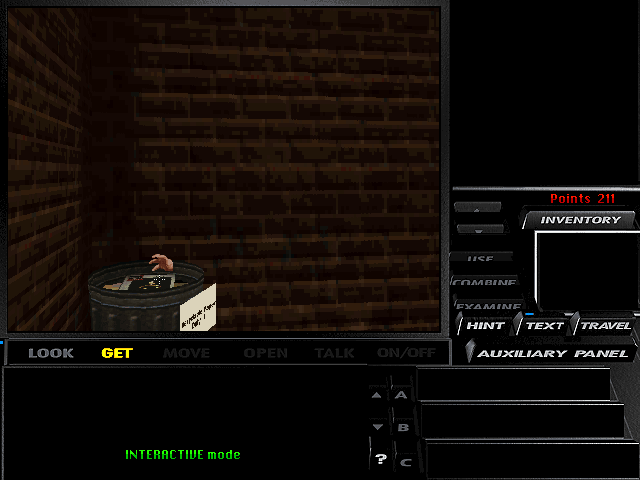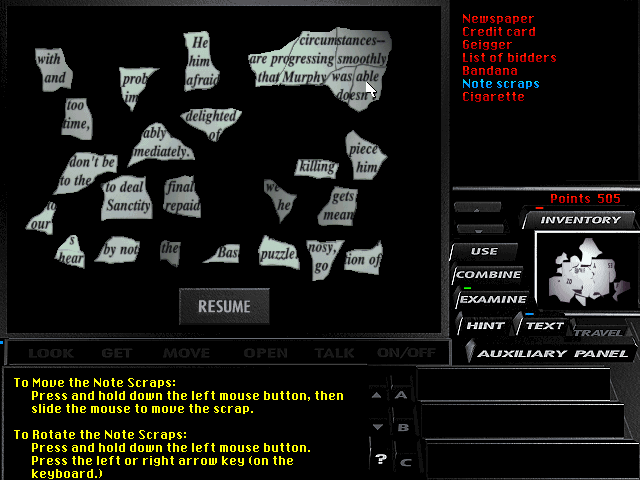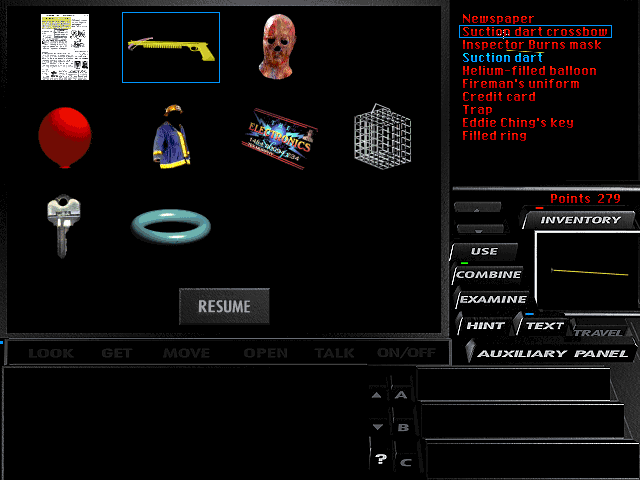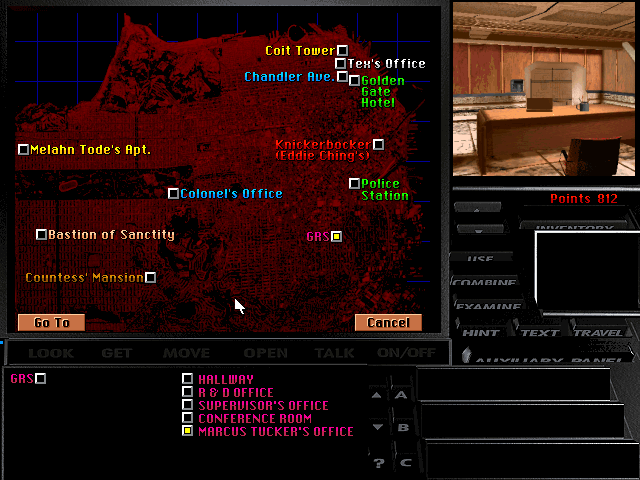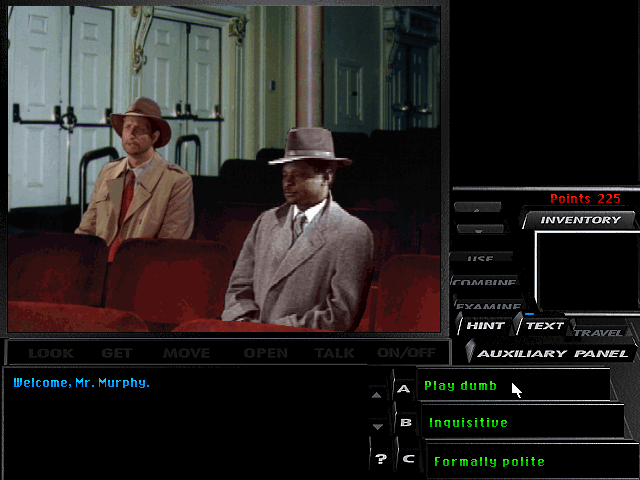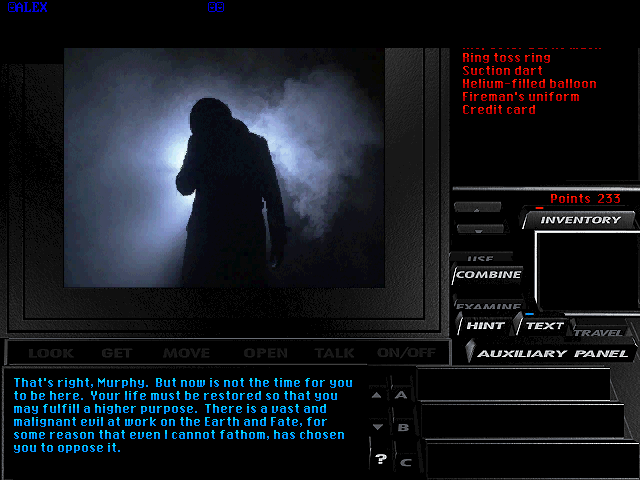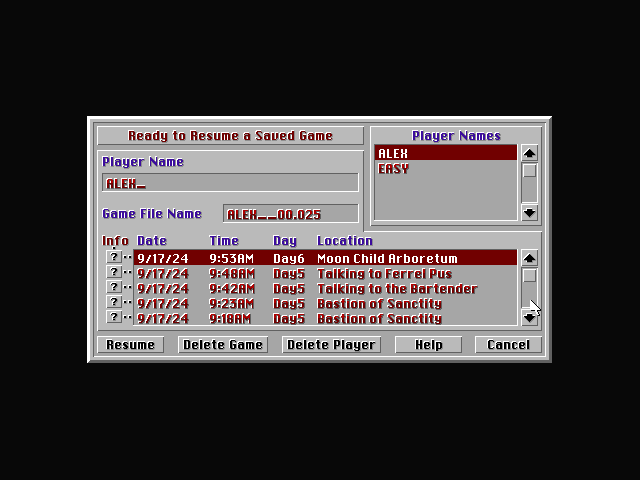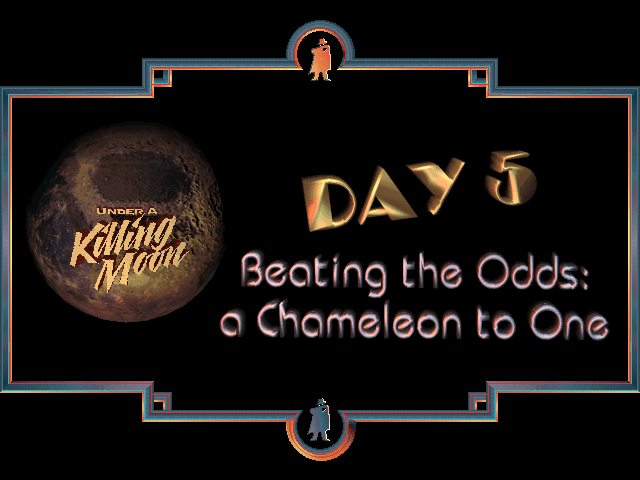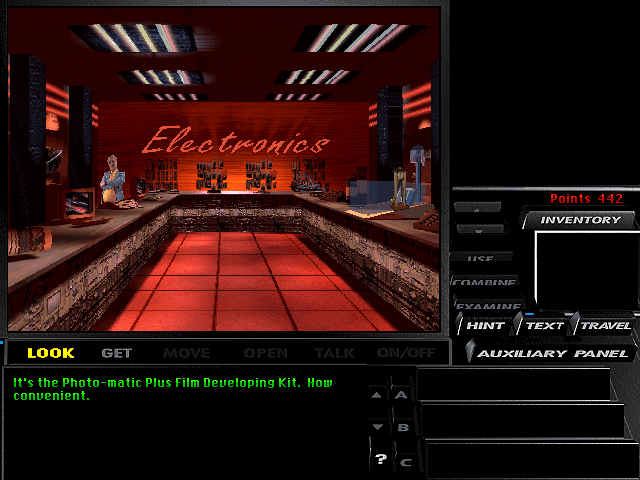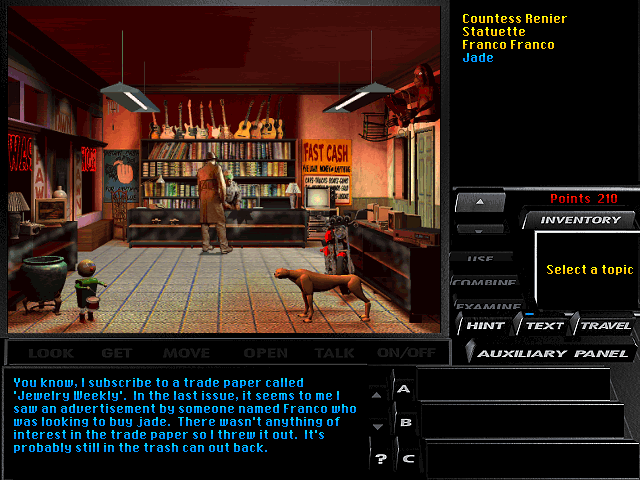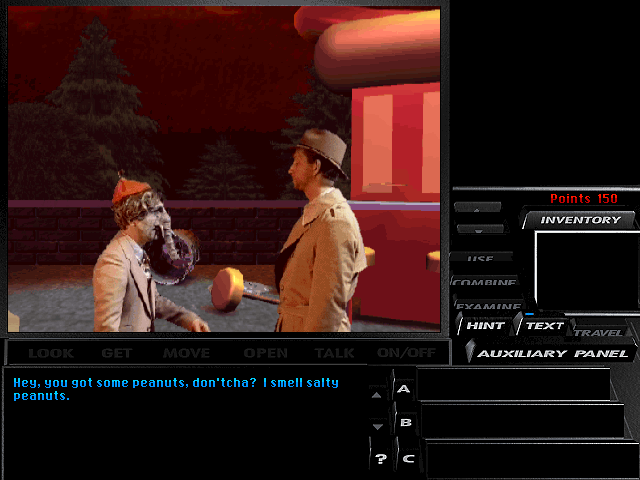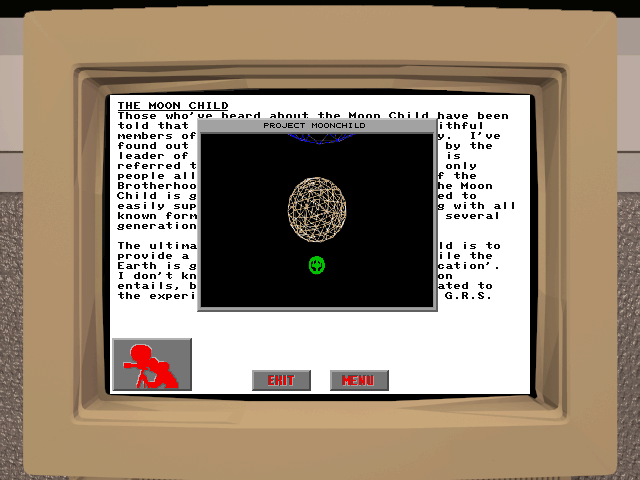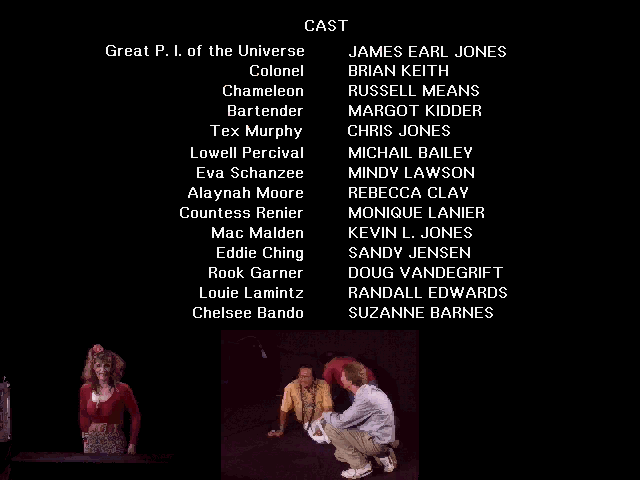Under a Killing Moon (Access Software) - 1994
Series: Let's Adventure! A Journey into Adventure Games (1980-1999)This review is part of the Let's Adventure! series. See all reviewed games sorted by rating here.
- ← The Scoop (Telarium) - 1986
- Under a Killing Moon (Access Software) - 1994
- → Space Quest 6: The Spinal Frontier (Sierra On-Line) - 1995
Article 87 of 101 in this series.
Under a Killing Moon is a 1994 point-and-click adventure interactive movie video game. It is the third installment in the Tex Murphy series of adventure games produced by Access Software.
It is December of the year 2042. The world is still recovering from the disastrous consequences of the World War III. Radioactivity has turned many humans into mutants, and the gap between those and the “norms” (non-affected humans) is growing wider. Certain places in the world have retained the feel and the charm of the old times - among those is the Old San Francisco. There, the private investigator Tex Murphy is trying to deal with unemployment, upcoming poverty, and his melancholic mood following his divorce. After solving a simple robbery case, Tex attracts the attention of a mysterious woman who calls herself Countess Renier, and is hired by her to find a missing statuette. Things gradually begin to go wrong in this investigation, and Tex finds himself involved in a confrontation with a powerful and dangerous secret cult.1
Under a Killing Moon is the sequel to Access Software’s previous title Martian Memorandum. Though I haven’t played through this one yet, I have previously covered Mean Streets and Countdown - the first being a Tex Murphy adventure.
I’m a fan of old detective movies and the film noir genre in general, so the introductory cut scene really hooked me right away and drew me into the dystopian future that was this game’s world.
Right from the beginning you feel like you’re in a movie, which if you’ve watched the documentary “The Making of Tex Murphy” reinforces this further as the game developers really wanted to make movies.
According to The Digital Antiquarian’s Under a Killing Moon article, Tex Murphy first appeared in Plan 10 from Outer Space before eventually being repurposed as the protagonist in various Access Software titles:
Vandegrift had recently returned to Bountiful to take a job as Access’s art director, and was more than up for Jones’s plan. The two had dreams of showing at Sundance as they wrote a script that combined The Maltese Falcon with Close Encounters of the Third Kind. Jones took the starring role of a private detective born in the wrong time, who channeled not only Humphrey Bogart but also Roy Rogers, what with his penchant for yodeling cowboy tunes. The detective-cum-cowboy’s name was Tex Murphy.
Before diving into Under a Killing Moon, you first need to install and configure it. There’s something really nostalgic about the design of these DOS era configuration screens that try to make it as easy as possible to configure your sound card.
I’m pretty sure I never had more than one device ever (at a time) so my digital sound and music devices were always the same, but in this modern age of emulation, might as well splurge and setup a faux-MT 32 for all the music this game has to offer.
You play as Tex Murphy, who’s a down on his luck private investigator looking for his next job. The game opens with a cinematic cutscene, then drops you into Tex’s office, which you can fully explore in 3D.
The game comes with 2 navigation modes - interactive and exploration. When you’re in exploration mode, you can move around the environment as if you’re playing DOOM. Tex can look all around using the mouse to control your field of vision, but you can also “stand” and “crouch” to see above and below things.
A pretty big part of the game’s puzzle design revolves around this mechanic of panning and tilting the camera to see over and into things. If there’s ever a trash can in a room, it’s worth having a look into as there’s usually something in there you’ll need to GET.
What you’ll often find in these trash cans are pieces of notes you’ll need to reassemble. This can be extremely time consuming to complete, but the game does at least give you instructions each time that lets you know what the goal of the puzzle is, and how to manipulate the pieces.
Each note reassembly puzzle is slightly different, so I appreciate that it didn’t just feel like busy work, but it’s obvious the designers were proud of this mechanic and wanted to reuse it as often as possible.
There’s more to collect in this game than just ripped up notes you need to put back together, and these are all stored in your inventory. Each item can be either examined, used or combined - and it’s worth trying all 3 of these options with literally everything you pick up.
Examining items is a requirement as many times the item you initially picked up isn’t actually the thing you want. Examining it shows a 3D view of the item as it’s rotated, and you may discover a compartment with a key, or you’ll open it up and take something out - discarding the initial item in the process.
Though there are several item combination puzzles, the end result is typically pretty obvious, so the various items you need to collect and combine to form the final item are also pretty obvious.
To navigate around the world of Under a Killing Moon, you have access to a quick travel map. New locations are added based on conversations with characters or by examining certain inventory items.
Many locations aren’t actually “explorable”, but simply contain a single character you can talk to. This can make the game world look a lot bigger than it is.
Since it’s REALLY easy to miss picking up key items in this game, the map is actually extremely useful. For locations (like Chandler Ave.) where there are several places you can visit, you can actually go directly to a key location right away by selecting it from the map.
The story progresses through interactions with a couple dozen characters you’ll meet throughout your adventure. Instead of the typical dialogue tree adventure games present you with, Under a Killing Moon relies on a 3 options system used to set the tone of the question you want to ask.
Typically the option you select won’t matter, and the conversation will proceed “on rails”, but if you’re not careful with certain people you’ll miss key details if you pick the wrong options - or even get yourself killed!
Dying in this game brings you back to the big detective in the sky, who will let you know it’s not your time yet and give you another chance.
You may also get a clue as to how you should have proceeded. Since this section is voiced by James Earl Jones, it’s at least a bit enjoyable hearing him reassure you that it’s not your time and you should get back out there and try again.
Hopefully you remembered to save your game recently, as restore a previous save is the only option here - other than restarting from the beginning.
Though saving early and often is pretty standard fare for an adventure game, it’s worth calling out Under a Killing Moon’s storage system.
When you start the game, you create a player, which is what you’ll be storing your games under. You can have multiple players with their own series of saves, which I guess if you’re sharing your computer with a sibling would be useful to keep your save games separated.
Each save automatically captures the current location, and you can even enter arbitrary notes about the save, which can also be handy.
The story unfolds over 7 days, with each day starting with a title card. Once you solve the case of the robbery from the pawn shop and realize you may want to get back into sleuthing, you’ll need to get your fax machine fixed so you can maybe get some new cases.
One of the locations you gain access to early on is an electronics store, which seems to always have exactly one item for sale - and that item always ends up being the thing you currently need (how convenient).
To get into the electronics store though, you’ll need some means to buy things - like a credit card. In your office you’ll find a stack of mail by the front door, which includes an application for a credit card.
Opening the drawers in your office will reveal a pen and an envelope, and combining those three items will create a “ready-to-mail application”, which you then just need to drop into a mailbox.
This is how a lot of these item combination puzzles work. There aren’t really all that many items on any day that you have access to, and it’s fairly obvious how they need to be used.
Whenever you go to the electronics shop, if there’s an item for sale, you’re going to need it - and it’s only a credit card swipe away. I’m pretty sure there’s no limit on the card, but you only need to use it a handful of times in this one store in the game where you have the power to buy anything.
Navigating the dialogue options properly with the electronics store owner is required on one of the later days, as you’ll need him to spill some info about the security system he just installed at the Knickerbocker hotel.
If you don’t pick the right options, he’ll end the conversation early. Since there are only 3 options available for each conversation you have, it’s worth testing all variations with all characters just in case.
During conversations with characters, you can also ask about various keywords. Not all characters will know about a all keywords, but this is how you advance your investigation.
You’ll also learn new keywords as you progress, and will need to backtrack to ask all characters about these to see if they can shed any light on the topic.
Under a Killing Moon does a great job of making this game world feel large and expansive, but there actually aren’t that many locations to visit or characters to interact with.
The balance they strike though of forcing you to backtrack without making it feel tedious is impressive.
Some characters you interact with are mutants, and may be disfigured. I know that earlier games go into more detail about what happened in the world for this to happen, but here they don’t really explore this very much.
Some people have developed a natural resistance against radioactivity, and thus are normal or “Norms” – everybody else are Mutants in some form. Tensions between the two groups have risen dramatically since the end of the war, and Norms and Mutants usually do not get along. […] The Law and Order Party has long since dissolved and disbanded but it still lives on in the more extremist and openly anti - mutant group The Crusade for Genetic Purity which now espouses a return to pre-WWIII society with Norms having full control of society without mutants.
You can ask characters about the crusade, but most won’t really give you much information.
I actually really love the backstory of this game and wish they’d leaned into world building a bit more, but I guess the expectation was you’d played through the previous games in the the series and were up to speed already.
As the game progresses you get wrapped up in a plot to eradicate all mutants (and I think humans considered “impure”) by raining down a virus from an orbiting space station known as the Moon Child.
Your mission then becomes to save Eva (who you learn infiltrated the CAPRICORN corporation’s cult and was sharing info via videos) from the Moon Child, blow up the station and return to Earth.
For a game considered the “largest video game ever” (at 4 CDs), Under a Killing Moon is fairly straightforward to complete.
This being an FMV game from the early 90s means you’re going to be treated to some questionable voice and character acting, but overall it’s not too bad.
James Earl Jones’ narrative does a great job of setting the tone of the game, and the brief sequences with Margot Kidder are enjoyable.
Navigating the game world’s 3D environment from a first person perspective made the exploration portions of the game very engaging, and since most scenes weren’t that big it didn’t feel like things were purposely hidden in weird places just to screw with you.
You really feel like you’re part of the story as it progresses, and the characters (typically) don’t feel two dimensional. The puzzles aren’t overly complicated, and though they can be a bit repetitive, don’t become tedious.
I had a lot of fun playing through Under a Killing Moon, and look forward to one day revisiting this world and its characters in The Pandora Directive, but given the rate at which I play through these games … that might take me a while.
Game Information
| Game | Under a Killing Moon |
| Developer | Access Software |
| Publisher | Access Software |
| Release Date | 1994 |
| Systems | DOS, Windows |
| Game Engine |
My Playthrough
| How Long To Beat? | 8.5 hours |
| Version Played | DOS via DOSBox-X |
| Notes | Walkthrough |
Score
See here for a refresher on how we’re scoring these games.
| Graphics (10) | 7 |
| Sound (10) | 7 |
| Plot / Progression (25) | 21 |
| Characters / Development (15) | 12 |
| Gameplay / Experience (15) | 11 |
| Replayability (10) | 4 |
| Impact / Impression (10) | 6 |
| Bonus / Surprise (5) | 3 |
| 71% |
Gallery
Footnotes
Description from Moby Games ↩︎
